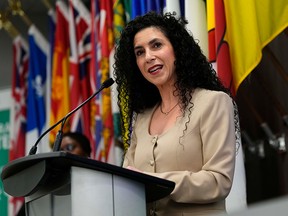How Canada Wins: A new government, whether it’s Conservative or Liberal, will have work to do fixing Canada’s immigration system
Article content
OTTAWA — The Liberal government’s recent reversal on the consumer carbon tax takes first prize for its biggest policy backpedal, but in a close second is a dramatic U-turn on immigration.
Article content
Article content
The Liberals came to power offering an expansive vision of immigration that saw permanent resident targets nearly double, from 260,000 in 2015 to a goal of 500,000 in 2025.
Advertisement 2
Article content
By 2023, when inflation was spiking after the pandemic and housing issues had grown into a full blown crisis, Canadians were starting to become skeptical that the country could handle the kind of population growth the Liberals envisioned. At the same time, population growth was hitting record levels.
Statistics Canada reported that over a three-month period in 2023, the country’s population grew by 430,635 people, representing a 1.1 per cent boost, which was the highest growth rate since 1957 when the country was in the throes of the post-war baby boom.
As the politics of immigration turned darkly against the Liberal government, a new minister was brought in to reverse his predecessor’s policies. Almost immediately after taking the job, Marc Miller slashed the number of foreign students in the country by a third and brought in a temporary cap on the student visa system, at least partly to help address the housing crisis.
Most surprisingly, given the Liberal government’s past policies and rhetoric on immigration, Miller also drastically reduced the number of permanent residents coming into Canada each year to a smaller target of 365,000 by 2027.
Article content
Advertisement 3
Article content
Even with these reforms, Canadians still think immigration has run wild, and a new government, whether it’s Conservative or Liberal, will have work to do fixing Canada’s immigration system. National Post spoke to Mikal Skuterud, a labour economist at the University of Waterloo in Ontario who has been urging changes for years, about key priorities for a new government to make Canadians worry less about immigration.
Give the minister time
A key way the new prime minister can turn the page from the Trudeau government is to give the minister of immigration some time to learn on the job.
When Liberal MP Rachel Bendayan was sworn in this month as Prime Minister Mark Carney’s immigration minister, she became the sixth person to hold the job in less than 10 years, with an average tenure of less than two years each. Skuterud said his ideal version of Canada’s immigration system arrived right at the end of former immigration minister Jason Kenney’s record-setting five-year tenure.
“I don’t think it was a coincidence that the longest serving immigration minister actually got it right. It’s a complicated portfolio,” said Skuterud. “You get captured by the private interests when you don’t really understand the system or the objectives. You’re just trying to play whack-a-mole, just trying to meet everybody’s needs.”
Advertisement 4
Article content
A key problem for a new minister is that there are lots of people lobbying for more immigrants, both temporary and permanent, and it takes experience to know when to say no when it doesn’t fit the government’s objectives or the country’s interest.
Recommended from Editorial
Know your objectives
It seems simple, but the government needs to understand what it is trying to achieve with its immigration system.
Is the government looking for long-term economic growth? Is it trying to bring in younger immigrants who can offset the country’s aging population?
In 2022, the government was faced with a labour shortage during the pandemic and looked to immigration to help solve it. That was part of the reasoning behind the skyrocketing number of temporary residents in the form of foreign students and temporary foreign workers.
Skuterud said it’s a short-sighted way to view immigration, when the government is using a vast, slow-moving system to solve short-term issues in the labour market.
Advertisement 5
Article content
“The big one was cooks. I just don’t understand that. As soon as you have a quota on how many new permanent residents are going to be admitted in the year, every cook that is prioritized for permanent residency is somebody else who isn’t going to be admitted, right?” said Skuterud.
Because foreign students were being used to ramp up revenue at Canadian post-secondary institutions — often to plug holes left by provincial budgets — the federal government lost track of the sheer number of people who were coming in. Many of these people were expecting to eventually get permanent residency and were encouraged to work part-time — filling labour shortages — meaning objectives at all levels of government were almost inadvertently aligned toward bringing in lower-skilled workers with almost no real oversight or direction.
Go back to a skills-based system
Skuterud said that as long as people see temporary residency as a path to permanent residency, the immigration numbers will always be high, which is why one of the government’s recent reforms was to include temporary numbers in the targets.
Advertisement 6
Article content
A fact of life for Canada, Skuterud said, is that there will always be more people who want to live here than the country can easily absorb.
One way to untangle those two tracks is to make permanent residency more skills-based and set a high bar for who qualifies, which is roughly how it was done in the decades before the Trudeau government came to power.
“I deeply, deeply care about Canada’s exceptional record on immigration and that success reflects the fact that Canada has a luxury, that it can pick and choose new immigrants, because it doesn’t have porous borders,” said Skuterud. “Since 1967, the way we said we’re going to do that is we’re going to prioritize skill.”
Skuterud argues there are economic advantages to bringing in higher-skilled immigrants who will be doctors, teachers and scientists because the best measure of a successful immigration system is the lifetime earnings of the people who come to Canada. Perhaps more importantly, Canadians are more likely to buy in to a system of mass immigration when it doesn’t feel like competition for their way of life, whether in jobs, homes or health care.
Advertisement 7
Article content
With an immigration target of roughly 0.8 per cent of the population before the Trudeau government came to power, Canada was still a relatively high immigration country compared to other countries. The difference then, Skuterud said, is that for 20 years before 2015 it barely made the headlines.
National Post
This is the latest in a National Post series on How Canada Wins. Read earlier instalments here.
Get more deep-dive National Post political coverage and analysis in your inbox with the Political Hack newsletter, where Ottawa bureau chief Stuart Thomson and political analyst Tasha Kheiriddin get at what’s really going on behind the scenes on Parliament Hill every Wednesday and Friday, exclusively for subscribers. Sign up here.
Our website is the place for the latest breaking news, exclusive scoops, longreads and provocative commentary. Please bookmark nationalpost.com and sign up for our daily newsletter, Posted, here.
Article content








